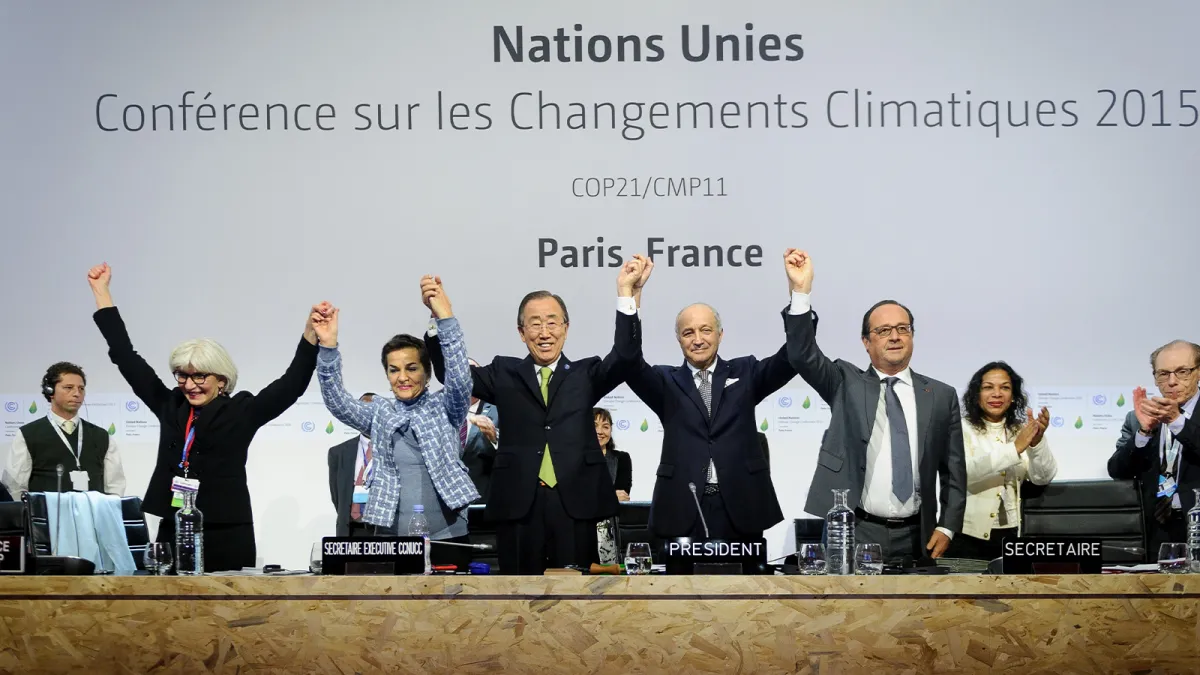How Target Setting Can Help Guide Climate Action
Setting achievable targets can help governments and companies plan their efforts to fight climate change and measure their progress.
Addressing climate change is a massive task. It requires transformational changes across nearly all of society over a long period of time. So, governments and businesses set climate targets that help guide their progress, motivate ambitious action, and keep them on track.
The best-known climate target is probably the goal of the 2015 Paris Agreement. Nearly two hundred countries have agreed that the world needs to limit global warming to well below 2°C (3.6°F), and ideally to 1.5°C (2.7°F) above preindustrial levels, by the end of the twenty-first century. Failing to achieve that goal could cause catastrophic changes to the climate.
To make progress toward the Paris Agreement’s overarching goal, policymakers have set out various smaller targets to guide their climate action.
What exactly are those targets? And how helpful are they in fighting climate change?
This resource explores climate targets: what they are, how they work, and what challenges they present for policymakers.
What is a climate target?
Climate targets are commitments that companies, governments, or groups of governments make to take certain actions or meet certain benchmarks in the fight against climate change. They provide a goal that policymakers can use to plan policies and measure their progress. If sufficiently ambitious, targets can help stimulate innovation as governments or businesses seek creative ways to meet their goals efficiently. Targets can also provide accountability if those governments or businesses fall short in their climate actions.
Climate targets come in all shapes and sizes. They can guide efforts to reduce harmful behaviors, or they can encourage the adoption of beneficial ones. Targets can also vary in scope. Some outline broad goals, such as reducing greenhouse gas emissions by a certain amount across an entire economy. Other targets take a narrow focus, such as eliminating specific pollutants.
Let’s take a closer look at some of the main categories of climate targets.
Emissions Reduction Targets: Many climate targets focus on decreasing the amount of carbon dioxide and other greenhouse gases released into the atmosphere. Emissions reduction targets come in two forms. Absolute targets aim to reduce total emissions by a specific amount. As part of the Paris Agreement, each country is required to submit a nationally determined contribution (NDC). NDCs outline an absolute emissions reduction target. For example, Brazil has committed to reduce its emissions by 59 to 67 percent by 2035, as compared to emissions levels in 2005. Intensity-based targets, on the other hand, aim to reduce the emissions produced per unit of output. In 2021, for instance, the manufacturer U.S. Steel promised by 2030 to reduce the amount of carbon it emits per ton of steel it manufactures by 20 percent compared to 2018 levels.
Net-Zero and Carbon Neutrality Targets: A specific type of emissions reduction target involves a country or company achieving net-zero emissions or carbon neutrality. Net-zero means that a country or company works to reduce its emissions as much as possible. It also aims to balance whatever emissions remain by removing an equivalent amount of carbon dioxide from the atmosphere through carbon capture or reforestation projects. Carbon neutrality similarly seeks to balance emissions, but it allows governments and companies to compensate for their emissions through less direct methods. These methods include purchasing carbon offsets, which fund emissions reduction projects. As of 2025, more than one hundred countries have pledged to reach net-zero emissions by 2050. Some countries and businesses have taken it one step further: they seek to become carbon negative, or to offset more emissions than they produce.
Energy Targets: Shifting to renewable energy sources is crucial in mitigating climate change. Many countries and companies have established targets to increase the amount of energy they generate from solar, wind, and other renewable sources. In 2023, for instance, 133 countries set a goal of tripling global renewable energy capacity by 2030. Other energy targets aim to transition away from fossil fuels. For example, more than eighty countries have pledged to phase out their using coal for electricity generation over the coming decades. Other countries have pledged to increase the amount of renewable energy they produce. China, for instance, has pledged to reach 1,200 gigawatts of wind and solar capacity by 2030.
Deforestation and Land-Use Targets: Forests play a vital role in absorbing carbon emissions and maintaining ecological balance. Many climate policies include targets for reducing deforestation and increasing reforestation projects. At a climate summit in 2021, for example, more than one hundred leaders signed a pledge to halt and begin reversing deforestation within their borders by 2030.
Adaptation Targets: Not all targets are about slowing climate change. Some climate targets guide countries and businesses in their efforts to adapt to the ways climate change is already harming society. In 2022, for example, the United Nations launched the initiative Early Warning for All, which aims to provide universal access to early-warning systems for extreme weather events by 2027.
How policymakers craft useful targets
The ideal target results in as much climate action as possible while still being achievable. Finding the right balance can be complicated, though. Policymakers look at several factors when designing climate targets.
Ambition: At the core of any target is how much it will achieve. If a target isn’t ambitious enough, it won’t help combat climate change as much as it could. Policymakers often look at two benchmarks to evaluate climate targets. They check whether they are compatible with meeting the 1.5°C goal of the Paris Agreement or with reaching a target of net-zero emissions by 2050. Scientists and organizations like the Intergovernmental Panel on Climate Change and the Science-Based Targets Initiative use climate models to evaluate targets and establish science-based standards. Governments and companies can then use those standards to set appropriately ambitious goals.
Achievability: If a target is too ambitious, governments and companies could dismiss it as unrealistic. They could also decide that the cost associated with worsening climate change is less than the cost of meeting a target. To ensure that targets are successful, policymakers work with economists to determine when the benefits of a certain target (such as lowering the likelihood of costly extreme weather events) outweigh the costs of achieving it (for instance, investing in new infrastructure or technologies). To compare the costs and benefits of certain climate targets, analysts often calculate what’s known as the social cost of carbon. This is an estimate of the economic damage of each additional ton of carbon dioxide emitted into the atmosphere. With an accurate measurement of carbon’s social cost, policymakers can fine-tune climate targets to ensure that the benefits of meeting them exceed the costs.
Flexibility: Climate science is an evolving field, and economic conditions change constantly around the world. Given those circumstances, policymakers often strive for a certain amount of flexibility in their climate targets. That entails providing leeway for organizations to meet targets in various ways that suit their needs. It can also mean breaking targets into distinct measurable periods, after which governments or companies will readjust and, ideally, ratchet up their ambition. Too much flexibility, however, can harm climate targets. If the leaders of organizations believe they can pressure policymakers into relaxing standards, climate targets could weaken over time.
Transparency: Targets are only valuable if governments and companies follow through with them. Some organizations have faced criticism for “greenwashing,” or exaggerating projects’ environmental friendliness, by publicizing ambitious targets without laying out clear plans for meeting those goals. To effectively measure headway and hold governments and companies accountable, targets need adequate systems for monitoring and reporting progress. Those involve building review and evaluation periods into climate targets, publishing results for public view, and soliciting evaluation from outside organizations.
Do climate targets work?
Climate targets can guide climate action, but they cannot necessarily guarantee progress.
Many countries and organizations fall short of meeting their climate targets. Take the Paris Agreement. If every country met the targets they set as part of the agreement, the world would still not achieve the goal of limiting global warming to 1.5°C by 2100. And most countries aren’t even on track to achieve their initial targets. In fact, the world is currently on pace to see up to 2.7°C of warming by 2100.
Part of the problem is that most climate targets are voluntary and self-determined. For example, the Paris Agreement requires countries to submit and update their commitments to fighting climate change, but there is little to stop them from submitting vague or weak targets.
Indeed, countries and companies generally face few immediate consequences—beyond the possibility of public criticism—for setting unambitious targets or failing to meet their goals. They can adjust or abandon climate targets easily, with dire implications for the planet. In 2025, for example, President Donald Trump announced that the United States would pull out of the Paris Agreement and drop many of its previously set climate targets. Many U.S.-based companies have correspondingly backed away from their own goals.
Still, climate targets remain an important tool for driving climate action. They can often spur action, even if that action falls short of the stated goals, when a country or organization would have otherwise done nothing. The world is not on track to honor the Paris Agreement, but it is closer than it was before the agreement was signed.
Some groups have successfully held countries accountable for shirking their climate commitments. In 2024, a group of Swiss women sued the Swiss government for failing to meet its climate targets and thereby endangering their health. They won the case, requiring the Swiss government to update its policies or face financial penalties.
As policymakers continue to seek ways to fight climate change, setting clear, science-based targets, implementing strategies to achieve them, and accounting for their progress will remain core drivers of climate action.






